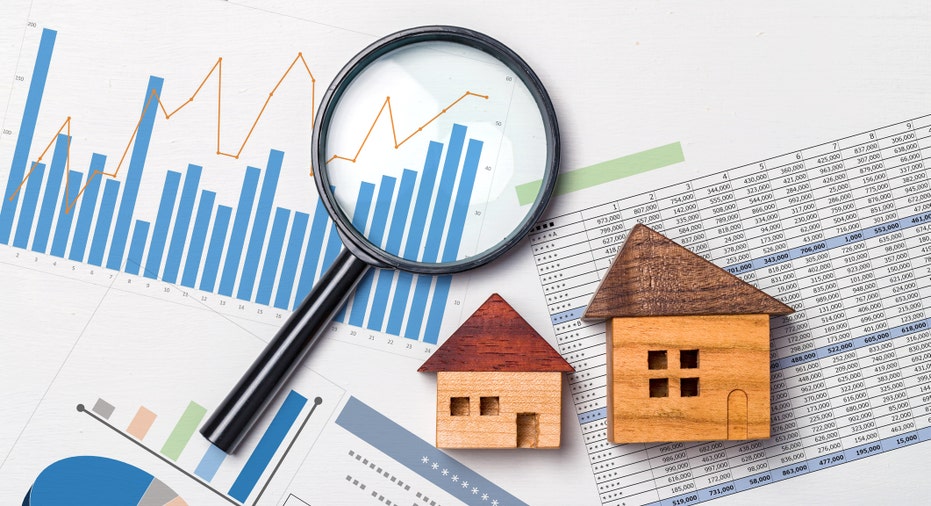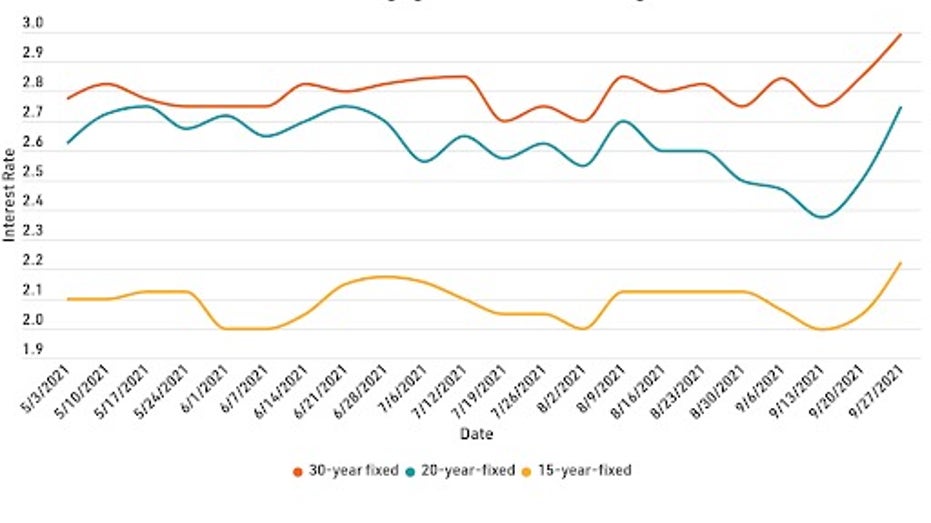Today's mortgage rates plummet back down to bargain-low territory | Oct. 4, 2021

Check out the mortgage rates for Oct. 4, 2021, which are down from last Friday. (iStock)
Based on data compiled by Credible, mortgage rates have fallen across all terms since last Friday.
- 30-year fixed mortgage rates: 2.875%, down from 2.990%, -0.115
- 20-year fixed mortgage rates: 2.500%, down from 2.750%, -0.250
- 15-year fixed mortgage rates: 2.125%, down from 2.250%, -0.125
- 10-year fixed mortgage rates: 2.000%, down from 2.125%, -0.125
Rates last updated on Oct. 4, 2021. These rates are based on the assumptions shown here. Actual rates may vary.
What this means: With all rates falling today, 20-year interest rates marked the biggest decrease — a quarter point. Homebuyers who want to lock in a lower rate and save on interest should act now, ahead of predicted rate increases. Realtor.com’s Manager of Economic Research George Ratiu recently told Fox Business "... the days of sub-3% mortgage rates may be in the rearview mirror by the end of 2021."
To find the best mortgage rate, start by using Credible, which can show you current mortgage and refinance rates:
Browse rates from multiple lenders so you can make an informed decision about your home loan.
Credible, a personal finance marketplace, has 4,500 Trustpilot reviews with an average star rating of 4.7 (out of a possible 5.0).
Looking at today’s mortgage refinance rates
After inching up last week, mortgage refinance rates opened this week near bargain-low territory. Homeowners who want to lock in a lower rate and save on interest should act now, as mortgage experts predict that rates will soon rise. If you’re considering refinancing an existing home, check out what refinance rates look like:
- 30-year fixed-rate refinance: 2.875%, down from 2.990%, -0.115
- 20-year fixed-rate refinance: 2.625%, down from 2.750%, -0.125
- 15-year fixed-rate refinance: 2.125%, down from 2.250%, -0.125
- 10-year fixed-rate refinance: 2.125%, unchanged
Rates last updated on Oct. 4, 2021. These rates are based on the assumptions shown here. Actual rates may vary.
A site like Credible can be a big help when you’re ready to compare mortgage refinance loans. Credible lets you see prequalified rates for conventional mortgages from multiple lenders all within a few minutes. Visit Credible today to get started.
Credible has earned a 4.7 star rating (out of a possible 5.0) on Trustpilot and more than 4,500 reviews from customers who have safely compared prequalified rates.
Why do mortgage rates fluctuate?
If you follow mortgage interest rates for a few days, you’ll likely notice that rates can fluctuate by a bit — or a lot — from day to day. Many factors drive these fluctuations. Here are some of the most common reasons why mortgage rates move frequently:
Employment patterns
The job market has a widespread effect on the nation’s overall economic health. When more people are out of work, the economy suffers. When more people are fully employed, the economy benefits. The employment rate is also an indicator of demand for mortgages.
When more people are unemployed, fewer people will be looking to get a mortgage and buy a home — and that lower demand will push interest rates down. When the employment rate improves, demand for mortgages will likely keep pace. And as demand for mortgages rises, so will mortgage interest rates.
The bond market
Because bonds are a lower-risk type of investment, demand for bonds can increase when investors are wary of other investment vehicles, or fearful of the overall state of the economy. Increased demand for bonds causes their price to rise and their earnings — called their yield — to fall.
When bond yields fall, consumer interest rates generally do as well, including mortgage interest rates. When investors feel more confident about the economy, demand for bonds declines, bond prices drop and yields rise. And interest rates tend to follow.
Federal Reserve System
"The Fed," as it’s commonly called, is the United States’ central bank. But it doesn’t actually set mortgage rates. Rather, multiple things the Fed does influence mortgage rates. For example, while mortgage rates don’t mirror the Fed funds rate — the rate banks apply when borrowing lending money to each other overnight — they do tend to follow it. If that rate rises, mortgage rates typically rise in tandem.
The Fed also buys and sells mortgage-backed securities, or MBS — a package of similar loans that a major mortgage investor buys and then resells to investors in the bond market. Rates tend to be lower when the Fed is doing a lot of buying. When the Fed buys fewer MBS, demand falls and rates will likely rise. Similarly, when the Fed raises the Fed fund rate, mortgage rates will also increase.
Global economy
Global banking systems and economies are closely interconnected. When economies in other parts of the world — especially Europe and Asia — experience a downturn, it affects investors and financial institutions in the United States. And, when foreign economies are doing well, they may attract more American investors — and divert those investment dollars out of the U.S. economy.
Those global influences contribute to the overall health of the U.S. economy. When the domestic economy is doing well, interest rates rise. And when the American economy falters, interest rates fall.
Current mortgage rates
After rising above 2.5% for four days last week, today’s average mortgage interest rate fell back down to just 2.375%.
Current 30-year mortgage rates
The current interest rate for a 30-year fixed-rate mortgage is 2.875%. This is down from last Friday. Thirty years is the most common repayment term for mortgages because 30-year mortgages typically give you a lower monthly payment. But they also typically come with higher interest rates, meaning you’ll ultimately pay more in interest over the life of the loan.
Current 20-year mortgage rates
The current interest rate for a 20-year fixed-rate mortgage is 2.500%. This is down from last Friday. Shortening your repayment term by just 10 years can mean you’ll get a lower interest rate — and pay less in total interest over the life of the loan.
Current 15-year mortgage rates
The current interest rate for a 15-year fixed-rate mortgage is 2.125%. This is down from last Friday. Fifteen-year mortgages are the second most-common mortgage term. A 15-year mortgage may help you get a lower rate than a 30-year term — and pay less interest over the life of the loan — while keeping monthly payments manageable.
Current 10-year mortgage rates
The current interest rate for a 10-year fixed-rate mortgage is 2.000%. This is down from last Friday. Although less common than 30-year and 15-year mortgages, a 10-year fixed rate mortgage typically gives you lower interest rates and lifetime interest costs, but a higher monthly mortgage payment.
You can explore your mortgage options in minutes by visiting Credible to compare current rates from various lenders who offer mortgage refinancing as well as home loans. Check out Credible and get prequalified today, and take a look at today’s refinance rates through the link below.
Thousands of Trustpilot reviewers rate Credible "excellent."
Rates last updated on Oct. 4, 2021. These rates are based on the assumptions shown here. Actual rates may vary.
How Credible mortgage rates are calculated
Changing economic conditions, central bank policy decisions, investor sentiment, and other factors influence the movement of mortgage rates. Credible average mortgage rates and mortgage refinance rates are calculated based on information provided by partner lenders who pay compensation to Credible.
The rates assume a borrower has a 740 credit score and is borrowing a conventional loan for a single-family home that will be their primary residence. The rates also assume no (or very low) discount points and a down payment of 20%.
Credible mortgage rates will only give you an idea of current average rates. The rate you receive can vary based on a number of factors.
How mortgage rates have changed
Today, mortgage rates are mostly down compared to this time last week.
- 30-year fixed mortgage rates: 2.875%, down from 2.990% last week, -0.115
- 20-year fixed mortgage rates: 2.500%, down from 2.750% last week, -0.250
- 15-year fixed mortgage rates: 2.125%, the same as last week
- 10-year fixed mortgage rates: 2.000%, down from 2.125% last week, -0.125
Rates last updated on Oct. 4, 2021. These rates are based on the assumptions shown here. Actual rates may vary.

These rates are based on the assumptions shown here. Actual rates may vary.
If you’re trying to find the right rate for your home mortgage or looking to refinance an existing home, consider using Credible. You can use Credible's free online tool to easily compare multiple lenders and see prequalified rates in just a few minutes.
With more than 4,500 reviews, Credible maintains an "excellent" Trustpilot score.
Fixed-rate vs. adjustable-rate mortgage
With a fixed-rate mortgage, your interest rate will remain the same for the life of your loan. At the beginning of your loan, you’ll know exactly how much total interest you’ll pay. But the rate can — and usually does — change with an adjustable-rate mortgage, or ARM. This means the total interest cost of the loan will also change.
ARMs tend to have introductory interest rates that are lower than fixed rates. But when the introductory period ends, the rate can move based on market factors.
Fixed-rate loans can be good for people who know they’ll be in their homes long term. ARMs may be a good option for people who don’t expect to stay in a home long, or who are confident they’ll be able to refinance into a fixed-rate loan when the introductory rate ends.
30-year vs. other terms
The repayment term is the number of years over which you’ll pay back your mortgage. Common terms for fixed-rate mortgages are 30 (the most common), 20, 15, and 10 years.
Generally, the longer your repayment period, the higher your interest rate and total interest costs will be, but you’ll have a lower monthly payment. With shorter terms, you’ll usually get a lower interest rate and total interest costs, but a higher monthly payment.
Conforming vs. jumbo loans
Conforming loans are for amounts that fall below Fannie Mae and Freddie Mac’s established limits. Jumbo loans exceed that limit, which is $548,250 for a single-family home in 2021.
Looking to lower your home insurance rate?
A home insurance policy can help cover unexpected costs you may incur during home ownership, such as structural damage and destruction or stolen personal property. Coverage can vary widely among insurers, so it’s wise to shop around and compare policy quotes.
Credible is partnered with a home insurance broker. If you're looking for a better rate on home insurance and are considering switching providers, consider using an online broker. You can compare quotes from top-rated insurance carriers in your area — it's fast, easy, and the whole process can be completed entirely online.
Have a finance-related question, but don't know who to ask? Email The Credible Money Expert at moneyexpert@credible.com and your question might be answered by Credible in our Money Expert column.
As a Credible authority on mortgages and personal finance, Chris Jennings has covered topics that include mortgage loans, mortgage refinancing, and more. He’s been an editor and editorial assistant in the online personal finance space for four years. His work has been featured by MSN, AOL, Yahoo Finance, and more.